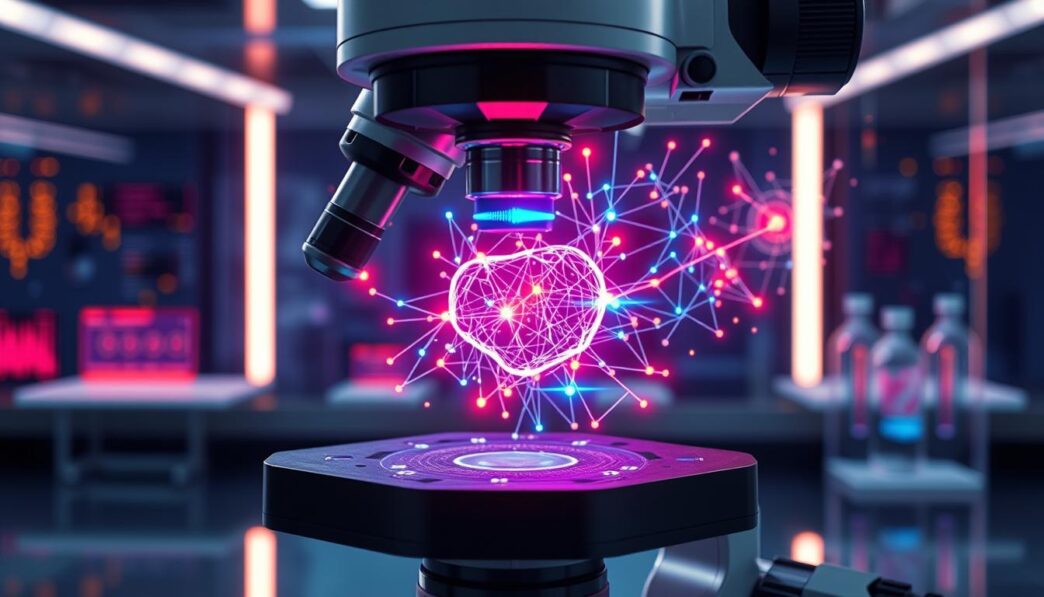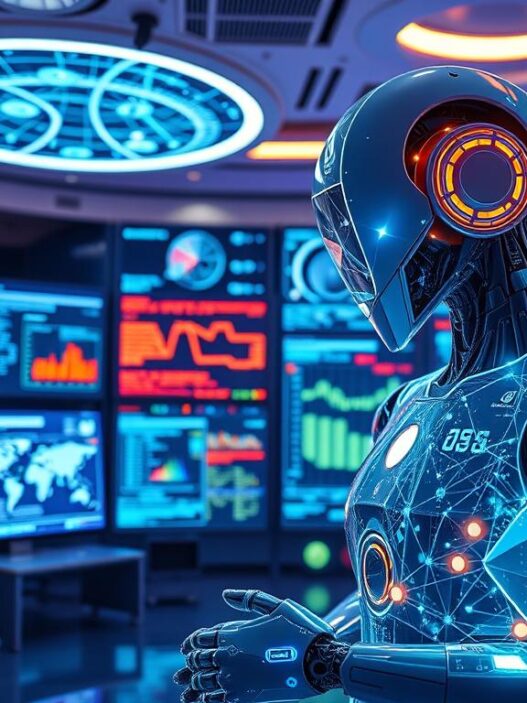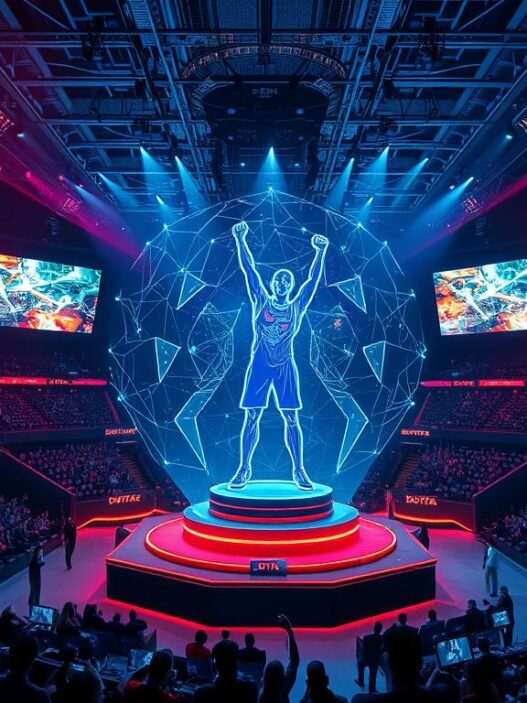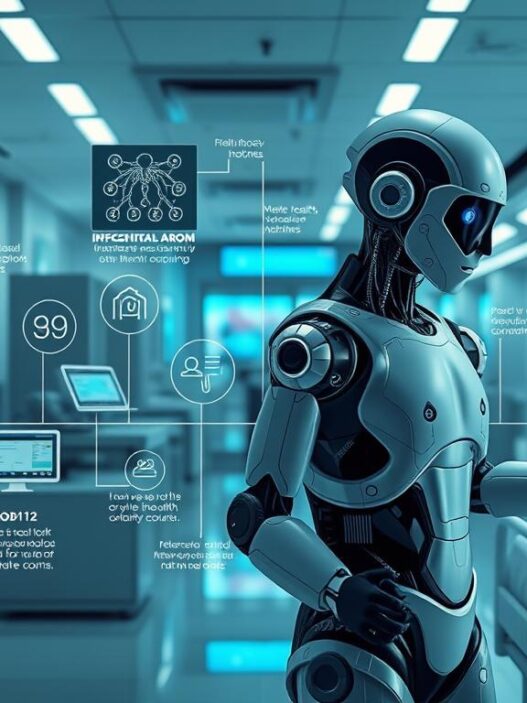OpenAI Microscope brings a deep dive into neural network models. It provides a unique view into how image data is processed. With this impressive platform, every key layer and neuron in modern computer vision (CV) models is made clear. This allows both researchers and enthusiasts to uncover the hidden aspects of these systems1.
The OpenAI Microscope is a mark of progress in visual models and a guide for future study. It gives both experts and beginners a real look at how neural networks learn and sort visual data2.
Key Takeaways
- OpenAI Microscope gives deep insights into eight leading CV models, ready for more discoveries1.
- It shows us how AI interprets images step by step, enhancing our understanding1.
- This tool makes researching neurons faster, leading to quicker findings1.
- Thanks to open-source tools like Lucid, OpenAI Microscope offers its results for everyone to use, promoting teamwork2.
- It helps various professionals, like brain researchers to pathologists, by making neural networks easier to understand2.
- OpenAI Microscope is crucial for comparing AI models, enhancing cooperation and insight like never before1.
- The project grows by adding community work, using libraries like Lucid, Keras, and PyTorch’s Captum2.
A Deep Dive into AI Model Understanding with OpenAI Microscope
The OpenAI Microscope gives us a detailed look at neural networks. These are used in figuring out images and understanding AI. By showing key parts of popular models, it helps both experts and fans learn about the complex ways these systems work3.
The OpenAI Microscope has many visual tools to make understanding easier. You can see a graph that shows how ‘units’, like neurons, work together. This helps us get a better idea of how neural networks improve their abilities, helping with learning and new discoveries in AI3.
| Model | Neurons (Units) | Significant Layers |
|---|---|---|
| Model 1 | 100+ | 8 |
| Model 2 | 150+ | 8 |
| Model 3 | 200+ | 8 |
With the OpenAI Microscope, exploring neurons takes seconds, not minutes. This lets researchers quickly learn about how neural networks act3. It’s not just fast but pushes the limits of what we can discover about these networks.
“OpenAI Microscope’s lasting impact on AI is huge,” said David Ha from Google Brain. He thinks this tool will be remembered for a long time3.
Right now, this tool focuses on eight computer vision models. But there are plans to add more in the future3. This shows it can keep up with the quickly changing world of AI tech.
OpenAI Microscope also lets users share what they find through a special communication channel. This encourages people to work together, leading to more discoveries in AI understanding3.
So, the OpenAI Microscope blends advanced visuals with quick data handling. It’s key for improving our grasp of neural networks. It marks a huge step towards clear and easy-to-understand AI systems.
The Intricate World of AI: Layers and Neurons Visualized
OpenAI’s Microscope lets us dive into the world of AI. It shows a complex network of interactions. Through visualizing AI, both experts and enthusiasts can explore neural networks. They see the layers and neurons that make advanced image recognition mechanics and neural behavior possible. This deep look helps us understand how AI makes decisions.
Visualizing Complex Models for Enhanced Comprehension
Seeing AI in action is not just for show. It’s a key part of understanding complex models. Tools like the Activation Atlas let researchers see how AI models see and tell apart things like “snorkel” from “scuba diver”. This insight into AI models helps clear up how they see and react to different things. It makes our understanding of these systems much better4.
The Functional Mapping of AI Model Internals
Tools like OpenAI Microscope show how AI layers work with parts of an image. Lower layers catch simple details like lines and colors. But the higher layers see the big picture and complex scenes. This bridges the gap from simple data processing to real-world AI use4.
Interactive Analysis of Image Recognition Mechanics
Interactive tools make it fun to see inside neural networks. Users can see how changes in data change responses in real time. This hands-on look at image recognition mechanics shows how AI learns and gets better. It’s key to understanding how neural networks improve their skills through learning and adjusting4.

As tech advances, we need clear views of how AI works. These innovations matter for both study and real-world AI applications.
### Comparison of Neural Activation by Layers
| Layer Depth | Response to Basic Shapes | Response to Complex Concepts |
|---|---|---|
| Lower Layers | High Responsiveness | Low Responsiveness |
| Higher Layers | Low Responsiveness | High Responsiveness |
Showing how each layer works gives clues to better AI systems. Understanding these layers through visuals and interactive analysis not only leads to better models. It also leads to AI that thinks more like humans. This helps machines understand and react like humans do.
Inside the Toolkit: Features of the OpenAI Microscope
The OpenAI Microscope is a top-tier neural network toolkit. It stands out by offering a rich set of visualization features. These features help us understand complex AI models better5.
This toolkit has many tools that reveal what’s inside neural networks. It includes exBERT and BertViz for deep dives into transformer models. Users can examine attention mechanisms in real-time, gaining valuable insights into how models work56.
| Feature | Description | Utility |
|---|---|---|
| exBERT | Supports interactive investigations of transformer models | Enables detailed analysis of model reasoning |
| BertViz | Visualizes attention in Transformer language models | Facilitates understanding of attention mechanisms |
| TensorBoard Embedding Projector | Graphical representation of embeddings | Examines high dimensional embeddings |
| Feature Inversion | Visualizes activations from image networks | Creates an activation atlas for concept representation |
| Logit Lens | Interprets probabilistic predictions of GPT models | Provides insights into what the model ‘believes’ at different processing stages |
These features offer a detailed view of AI behaviors. The Language Interpretability Tool (LIT) is a standout for NLP model analysis. It uses various methods designed for processing natural language, making debugging and model improvement easier5.
The OpenAI Microscope reveals how different AI models work. It supports research in image models, language processing, and reinforcement learning. Innovative discoveries, like multimodal neurons, are changing how we understand AI56.
To master these tools, users navigate from simple Python libraries to advanced visuals like the TensorBoard Embedding Projector5. Every tool in the OpenAI Microscope makes neural networks clearer for all6.
In conclusion, the OpenAI Microscope toolkit changes how we see and work with artificial intelligence. It’s a big step in making AI more open to everyone.
Advancing Neural Network Research with OpenAI Microscope
Neural network research has grown a lot with the OpenAI Microscope. This tool helps us understand basic and advanced concepts in the field. It makes it easier to see how complex networks act, helps people work together, and compares studies. This is key in improving artificial intelligence.
Reducing the Feedback Loop in Neuron Exploration
OpenAI Microscope has made exploring neurons faster, cutting down feedback time from minutes to seconds. This speed helps analyze data quickly and test out ideas. It makes finding out how neural networks work easier and faster7.
Groundbreaking Discoveries in High-Low Frequency Detectors
The OpenAI Microscope helps us understand neural networks better8. It has found high-low frequency detectors in them. These detectors improve how neural networks perform by dealing with different frequencies8.
Facilitating Comparative Studies and Collaboration
The OpenAI Microscope encourages working together through Circuits Collaboration. Researchers can study neural networks deeply together. This helps understand how these networks operate. The tool shows neuron actions and connections in real-time. This is great for teamwork and new ideas in AI7.
With the OpenAI Microscope, we’re finding new things in neural network research. It gives clear details on neurons and makes research faster. It’s a big step forward in AI technology.

Conclusion
Exploring AI models with the OpenAI Microscope reveals a hidden world of neurons and networks. It helps us deeply understand research for the future. OpenAI started in 2015 by famous people like Elon Musk and Sam Altman. They focused on making neural networks clearer and improving AI910. As AI spreads into different fields, tools like the OpenAI Microscope are key. They help companies make better automation and decisions. This is important in areas like healthcare, finance, and insurance9.
OpenAI Microscope shows the group’s commitment to open and clear research. This means a big step towards AI that is developed responsibly10. OpenAI has made big advances in creating smart models and learning algorithms. These advancements make cybersecurity better, improve customer service, and help solve problems together. This improves businesses and takes customer service to new levels9.
For researchers, the OpenAI Microscope is central to new findings. Studying networks like InceptionV1 helps uncover secrets similar to the human brain. This brings a new wave of ideas in AI and brain science1110. There’s a growing focus on making neural networks understandable. This ensures AI develops ethically and with global well-being in mind10.




















